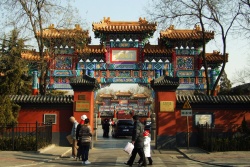Yonghe Temple
The Yonghe Temple 雍和宮, also known as the "Palace of Peace and Harmony Lama Temple", the "Yonghe Lamasery", or - popularly - the "Lama Temple" is a temple and Monastery of The Geluk School of Tibetan Buddhism located in the northeastern part of Beijing, China. It is one of the largest and most important Tibetan Buddhist Monasteries in the World. The building and the artworks of the temple is a combination of Han Chinese and Tibetan styles.
History
Building work on the Yonghegong Temple started in 1694 during the Qing Dynasty. It originally served as an official residence for court eunuchs. It was then converted into the court of the Prince Yong (Yin Zhen), a son of the Kangxi Emperor and himself the future Yongzheng Emperor. After Yongzheng's ascension to the throne in 1722, half of the building was converted into a lamasery, a Monastery for Monks of Tibetan Buddhism. The other half remained an imperial palace.
After Yongzheng's Death in 1735, his coffin was placed in the temple. The Qianlong Emperor, Yongzheng's successor, gave the temple imperial status signified by having its turquoise tiles replaced with yellow tiles which were reserved for the emperor. Subsequently, the Monastery became a residence for large numbers of Tibetan Buddhist Monks from Mongolia and Tibet, and so the Yonghe Lamasery became the national centre of Lama administration.
The temple is said to have survived the Cultural Revolution due to the intervention of Prime Minister Zhou Enlai. It was reopened to the public in 1981.
Architecture and artworks
The Yonghe Temple is arranged along a north-south central axis, which has a length of 480m. The main gate is at the southern end of this axis. Along the axis, there are five main halls which are separated by courtyards: the Hall of the Heavenly Kings (Tian Wang Dian or Devaraja Hall), the Hall of Harmony and Peace (Yonghegong), the Hall of Everlasting Protection (Yongyoudian), the Hall of the Wheel of the Law (Falundian), and the Pavilion of Ten Thousand Happinesses (Wanfuge).
The Hall of the Heavenly Kings is the southernmost of the main halls, it served originally as the main entrance to the Monastery. In the center of the hall stands a statue of the Maitreya Buddha, along the walls Statues of The Four Heavenly Kings are arranged.
The Hall of Harmony and Peace is the main building of the temple. It houses three bronze Statues of the Buddhas of the Three Ages, the statue of the Gautama Buddha (Buddha of the Present) is in the center, it is flanked by the statue of Kasyapa Matanga (Buddha of the Past, Right) and the Maitreya Buddha (Buddha of the Future, left). Along the sides of the hall, the Statues of the 18 Arhats are placed. A mural in the hall shows the Bodhisattva Avalokitesvara.
The Hall of Everlasting Protection was Emperor Yongzheng's living quarters as a prince and the place where his coffin was placed after his Death. Today, a statue of the Bhaisajya-Guru (Healing Buddha) stands in this hall.
The Hall of the Wheel of the Law functions as a place for reading scriptures and conducting religious ceremonies. It contains a large statue of Je Tsongkhapa, founder of the Geluk School. The hall also contains the Five-Hundred-Arhat-Hill, a carving made of red sandalwood with Statues of the Arhats made from five different metals (gold, silver, copper, iron, and tin).
The Pavilion of Ten Thousand Happinesses contains an 26m tall (18m above the ground and 8m underneath) statue of the Maitreya Buddha carved from a single piece of White Sandalwood. The statue is one of three artworks in the Temple which were included in the Guinness Book of Records in 1993.
Three fabulous artworks
- three bronze Statues of the Buddhas of the Three Ages
- Five-Hundred-Arhat-Hill
- 26m tall White Sandalwood statue of the Maitreya Buddha
Location
The Yonghe Temple is located in Beijing's Dongcheng District, near the northeastern corner of the Second Ring Road. Lines 2 and 5 of the Beijing Subway both stop at Yonghegong, as do a number of city buses. The postal address is: 12 Yonghegong Dajie, Beixinqiao, Dongcheng District, Beijing.


